Have you ever walked into a store and walked past the soda aisle, too tired to think about what type of drink you want to have?
As such, your hands probably landed on one of the brands you could recognize, among the countless and countless of other cans and bottles with names you’ve never heard before.
If you buy soda by default, you’ll probably also land on the world’s most powerful soda brand: Coca-Cola.
This goes to show the power of marketing, but more specifically, the power of branding.
Whether you know it or not, a lot of your purchase decisions are driven by branding, it feels a little scary when you think about it since it can feel like we’re actually not in control when we buy something.
And as humans, we want to feel like we’re in full control, not brainwashed by some advertisement.
Branding has a tremendously powerful influence on our purchase decisions as customers, and therefore, as companies, branding is something that you want to pay great thought into. Unfortunately, though, it’s often a marketing strategy that tends to be far down on companies’ priority.
But if I ask you to think about the greatest companies in the world, what would you say?
My answer to you would be:
That’s the difference between branding and sales/marketing.
Marketing is focused on driving instant results, sales. Branding is about separating yourself as a company, making it the only worthy and natural choice, thus gaining you tremendous market share long-term.
Because branding doesn’t yield instant results but is more about a long-term strategy, it tends to be neglected due to the fact that it costs money. Additionally, the strategies for working with branding has through history been quite limited. The good news, however, is that today, in this era, there’s a new kid on the block, and it’s called social media.
Social media is one of the most incredible branding tools out there, as it allows you to work with your social media branding strategy, without having to pay hundreds of thousands of dollars. Instead, you can reach your target audience instantly, and continuously impact your audience with your branding message.
In this article, you’ll, therefore, learn how to create a social media branding strategy, and how to leverage social media for branding?
You’re in for a real treat, so let’s dig right in.
What is branding?
Branding is defined as ”the process of giving a meaning to a specific company, products or services by creating and shaping a brand in consumers’ minds. It is a strategy designed by companies to help people to quickly identify their products and organization, and give them a reason to choose their products over the competition’s, by clarifying what this particular brand is and is not.”
This means that when it comes down to it, branding is about not only making your brand known, but it’s about making your audience and customers associate your brand with something and think about your brand in a certain way. Every person creates their own version of brands based on their perceptions and experiences, but the purpose of branding is to feed the audience with particular messages which will help the brand portray their brand in a particular way – the way they want to be thought of as.
If I ask you to think about iPhone, Pepsi, Sprite, or Skittles, you probably have your own idea about these brands in your head, and you associate them with different things and think of them in different ways.
This is not because you think differently of the companies from scratch, but it is because these companies have fed you with various marketing campaigns and messages focused on branding – not marketing, and ultimately, the goal of branding is to separate a brand so much from its competitors, which makes it unique and superior to all other brands – in the long-term. Not in the short term.
Of course, the fact that social media branding is a long-term strategy more than it is a short-term strategy is a problem for many companies, because they sacrifice their long-term industry domination for short-term instant gratification, which is sales.
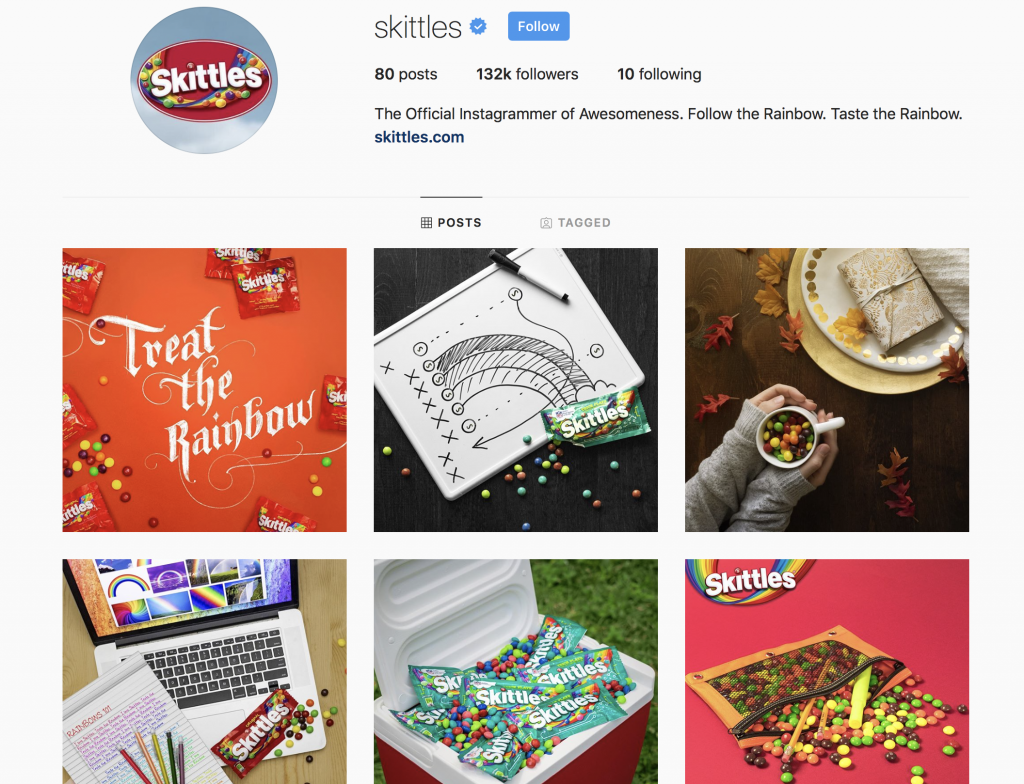
The good news, however, is that you don’t have to neglect one for the other. Social media branding can work alongside your marketing and sales efforts in order to create a successful marketing strategy which contains methods to both build your brand long-term, but also to keep it alive and running in the short-term.
With that said, are you ready to start building your social media branding strategy to create a brand that will dominate your industry in the future? Think Rolex for watches, Ferrari and Lamborghini for sports’ cars, and Nike and Adidas for sneakers.
How to Create a Social Media Branding Strategy
1. Set Goals
Oh no, not the boring ”set goals” point again.
Yes, I know, you’ve heard this a thousand times before, but before you do any marketing efforts, you should always set goals.
This is especially true when you’re creating more of a long-term strategy. In this case, a social media branding strategy.
The reason you want to set goals are several, but the two most important parts are:
- If you have no goals, you don’t know what you should work towards
- By developing goals, you’ll have an easier time measuring results.
By setting goals for your social media branding strategy, you’ll be able to make sure that the efforts you take help you actually get closer to your goal. Think of your goals as the checkpoints of a map, and think your social media branding strategy as a whole as your road map. Your goals help you know where you are going to go, while at the same time, your roadmap (Strategy) helps you get there.
Secondly. when you have goals, you’ll be able to measure the results from your efforts in an easier way. Now, branding isn’t the easiest metric to measure, but it is not the most difficult one either. Have you ever measured brand-awareness?
When you have set goals, you’ll be able to know exactly what you’re going to looking for when it comes to measuring and evaluating results, as opposed to trying to look under every rock you can find.
2. Choose Your Social Media Platforms
Now, remember that we’re going to do this on social media. Why? Because it’s a kick-ass marketing tool that you simply cannot afford to neglect.
The reason why some brands have become some superior to others think Coca-Cola and Apple, is that they have both played the long game, but at the same time, they’ve had the budget to actually work with branding. Marketing as a whole, with branding being no exception was expensive for brands before the age of the internet, and then also social media.
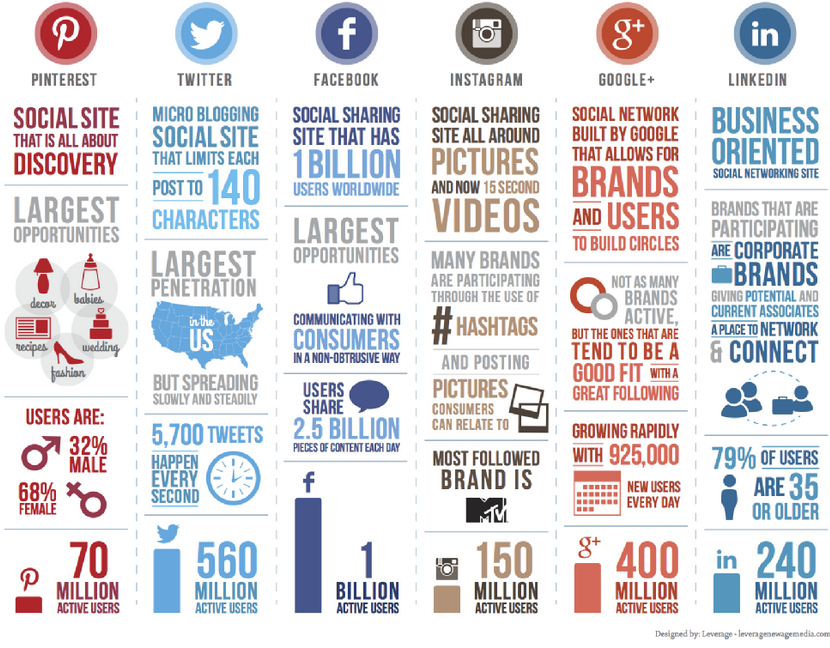
If you were to work long-term with branding, you would have to be prepared to pay for branding advertising after branding advertising, but without expecting to sell anything, in the hopes of the ROI showing itself in the future. The scary part?
You would never know if it would, and either way, you would have to invest quite the sims in order to see any results.
With social media, your branding marketing doesn’t have to cost a single dollar, only your own time, and if you are prepared to invest money into the process, you can spend far less money to generate far better results, because social ad targeting allows you to only reach the people who truly matter to your brand, not reach everyone (and paying to do so) and hoping that among those people are people from your target audience.
Now, this ties very well into my second point about choosing your social media platforms.
Your target audience is essentially the only group that matters to your brand. These are the only individuals who will buy from you, except if you’re thinking about your social media branding strategy in a super long macro-term, where some of the people who are not your target audience now become so in the future. Think alcohol and individuals who are under-age today, for example, but who will become of legal age in a few years – even though it’s a terrible example – but I think you get the point.
With that said, you shouldn’t be active on all social media platforms. This is because of the simple fact that not all social media platforms are relevant neither to your brand nor your social media branding strategy.
As such, you want to start by identifying the social network where your target audience spends the most time. This is important for your future efforts of social media branding. Another thing you want to factor into the equation is if those social platforms support your goal of which content to share because not all platforms are created equal.
As such, ask yourself the following:
- Which social media platform is your target audience using the most?
- Which social media platform is most relevant to your industry and brand?
- What type of content will best help you work with your social media branding strategy – which social platform is best for this?
3.Define your brand persona and how you want to be perceived
Your social media branding strategy is driven by how you want to be perceived and viewed by your target audience. Ultimately, this is what will help you separate from your competitors and become the only natural and obvious choice. But in doing this, you need to first define how you want to be perceived by your audience.
Brands like Coca-Cola, Red Bull, and Nike are all brands that are donating in their industry, but at the same time, they’re all so very different. This goes to show that there are many different routes to your final destination.
But which path is the right and most relevant for you?
The reason you need to define your brand persona and how you want your audience to think about you is so that all your social media branding strategy efforts are aligned with each other. You can think of your branding like your brand’s personality, and if you keep changing personality all the time, people will have a hard time resonating with you.
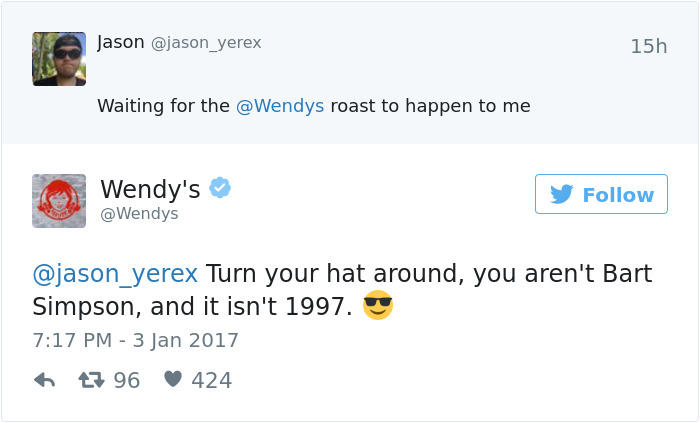
To define how you want to be perceived, ask yourself these questions:
- Who is your target audience? What do they resonate with?
- What type of brand are you? Luxury, affordable, exclusive etc?
- How do you want to be perceived by your audience?
- If you could choose one trait that would make them instantly think about you when they hear it, what would it be?
In accordance with this, you also want to define your target audience.
After all, it is your target audience that you do all of this for, and therefore, you want to develop a brand personality that aligns with them and their personality. If they don’t resonate with your branding strategy, it will be a complete fail, and it will mean that you didn’t cater to the right audience. Most likely due to too little research.
Consistency is key to a successful branding strategy. When focusing on short-term marketing results, such as sales, you can drive them right on the spot, but as for social media branding, it’s a little different, because, in order to etch a special message into your audience’s brain, you need to reach them consistently, and repeat your message time and time over.
This is why, you don’t only need to reach your audience many times, but you also need to make sure your message stays consistent. Otherwise, you’ll just tear down what you’ve built each time.

Consistency is not just about how you want your audience to perceive you, either.
It’s also important that you remain consistent in your social media branding strategy efforts as well.
In fact, 60% of US millennials expect consistent experiences, when dealing with brands online, in-store or by phone. That’s quite substantial. And this doesn’t factor in the long-term results and benefits that consistency in social media branding gives long-term.
The first and most fundamental part of social media branding is your social media accounts. Now that you’ve chosen social media platforms to use, you probably have more than one platform. And chances are, your audience will follow you on several of them. Or at least look you up.
This is why you need to be consistent in your social media platforms.
If you take a look at Coca-Cola’s social media accounts, you’ll see that they’re set up spot on.
Their Instagram account:
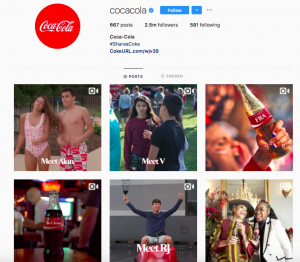
Their Twitter account:
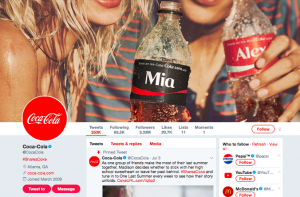
Their Pinterest account:
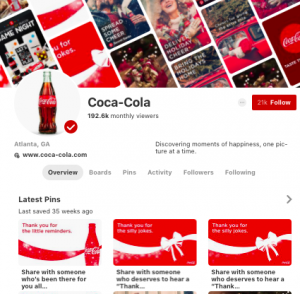
All of their accounts just scream Coca-Cola, and if you ever stumble across their accounts on social media, it’s hard to miss them.
They’re consistent, and they’re coherent. This does not only allow for a consistent social media branding message, but it also allows Coca-Cola to consistently impact their audience with their branding, and continuously etch their branding message in their audience’s brain – no matter which social media platform they use.
All social media networks are obviously different, but there are some key similarities that you want to have in mind when setting up your accounts:
Profile picture
All social media platforms allow for a profile picture. Ideally, you should have the same profile picture across all social media platforms as this is often what people see first.
As a brand, you want to have your logo, which is a part of your branding and making your audience associate and thinks of your brand when seeing it. If you have a personal brand, you want to have a face shot because ultimately, your face is your personal logo.
Bio
All social media platforms have a bio space where you can give brief information about your brand. This bio should be similar, if not identical across platforms.
Website link
Your website link isn’t really the most important thing about your social media branding strategy, however, if someone come across your profile and don’t know who you are and what you do, your website link is a great way to give people who are new to your brand some more context and information about who you are and what you do.
Most notably about Coca-Cola is their consistent color scheme, and this is an incredibly important part of any social media branding strategy. Oh, and this also brings me to my next point.
Have a consistent color scheme
The psychology of colors in marketing is a real thing.
You’re probably aware of the fact that humans are psychologically affected by colors as different colors evoke different feelings.
Just take a look at this emotion guide:
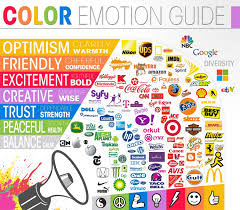
All great brands have a color scheme, and this is an incredibly important part of their branding. The reasons for this are many. First off, colors add another layer of recognition. Not only can you focus on your brand name and logo in your branding strategy, but you can also implement colors. Best of all is when your logo and brand colors work in harmony, as your colors can emphasize and empower your logo and people’s ability to recognize and remember it.
In other words, your level of impact when it comes to your social media branding.
Think of any large company and you’ll soon realize that all of them have a color that they’re associated with – whether you know it or not. And chances are, this has impacted you into buying from them. Coca-Cola’s iconic red is probably the most famous and best example of color branding done right. Then, you have McDonald’s with its yellow, Spotify with its green, and so on.
And these colors aren’t coincidences, nor are they just chosen because ”they look good”. Instead, there’s a real branding thought behind the color, because the emotions that the color evoke helps your branding, and make your audience perceive and think about you the way you want them to remember you. And trust me, this is a major deal in branding.
Your color should align with your brand persona and your overall social media branding strategy. It’s crucial that all of your efforts are aligned, and that one thing pulls in one direction, and another in the opposite because this will cause confusion and ultimately damage your end goal.
Create a content strategy
Content is everything on social media. Without high-quality content on social media, you have nothing, because ultimately, it is with your content that you’re going to reach your target audience and impact them with your social media branding messages.
The key to impacting them is thus by having great content. Your content is also your value proposition on social media. It is the reason why people start following you, and it is the reason why you attract people to your page.
But before you do anything, it’s important that you have in mind that not all social media platforms are created equal.
Instagram, for example, is a photo-sharing app. While it was solely focused on photos when it was launched, today it is all about visual content – both video and photo.
Twitter, on the other hand, is a text-based platform.
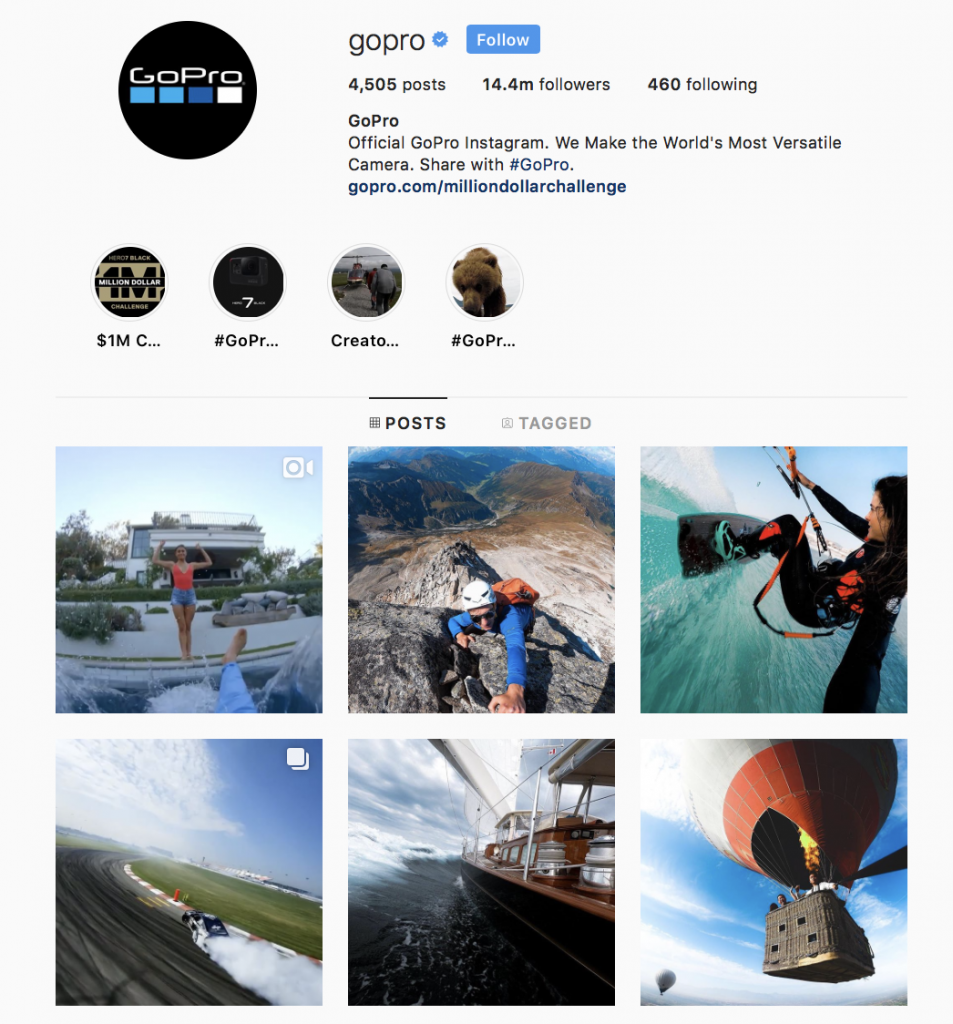
Furthermore, people use social media platforms differently and expect different things on them. This is why you shouldn’t share the exact same content on all your social media platforms. Now, this doesn’t mean that you have to create unique pieces of content for each social media platforms, because frankly, that would be extremely time-consuming. It’s simply enough to just create one piece of content and then repurpose that to make it suitable for all social media platforms.
But before you start thinking about repurposing content, you want to figure out what type of content your audience prefers, and what type of content they resonate well with. On social media, people follow different people for different reasons, and before you spend a bunch of time creating content for your social media branding strategy, you need to figure out what that reason is for your target audience. For example, while I may follow a champagne brand for champagne inspiration, I may follow an entrepreneur like Elon Musk because I want business advice and tips. But if all of a sudden, the champagne brand starts giving business advice, and Elon Musk starts sharing champagne inspiration, it will not only significantly harm their social media branding strategies and create a disconnect, but it will also most likely cause me to leave them.
There are also a bunch of other usage factors you want to have in mind when creating content for your social media platforms. For example, on Twitter, people expect you to share new, up-to-date, and timely content, but on Instagram, for example, it’s not as important that the information is recent.
Content types
Another thing you want to consider is the type of content you’re going to share, and as mentioned briefly, this varies across social platforms, but at the same time, on many social platforms, you can share many different types of content. To help you stay more aligned and consistent, it may be a good idea to choose a few content types and then stick with those.
Here are the most common content types for social media:
- Blog posts
- Webinars
- Case studies
- Ebooks
- How-to:s
- Behind the scenes
- Whitepapers
- Workbooks
- Podcast interviews
- Checklists
- Information
- Video guides and tutorials
Lastly, since content plays such a central role in all social media strategies, you want to consider what you are hoping to achieve with your content. Many companies on social media go all in on trying to share as many promotional messages and content as possible, until…. they realize it doesn’t work…. And they quit. While instead, the reality should have been that they realized it doesn’t work, and then understood that the ROI of something is predicated on your ability to use it, and then changed content strategies.
People on social media don’t want to have promotional content shoved in their face, but despite this, most companies use social media just like any other traditional advertising tool and go all in on advertising. The problem, however, is that people aren’t on social media because they want ads. Think about it… when you use social media privately, is that what you’re hoping to see?
Of course, not, you’re using it because you want to stay up-to-date with your peers, see what they are doing, interact with people, get entertained, and gain information and knowledge.
The problem is that most promotional posts don’t do any of that, and hence you’ll end up generating terrible results in marketing and in your social media branding.
As we talked about, consistency is crucial for social media branding. This is because a message and a brand cannot be built after just one interaction. It has to be repeated time and time over. So firstly, you want to create one-bit piece of content which aligns with your branding strategy and how you want to be perceived, and then, you want to repurpose this piece of content so that it keeps the initial core message, but is better optimized for the platform it is shared on.
Let’s take an example of how you can repurpose content for various social media platforms for your social media branding strategy:
- Create a YouTube video where you teach your audience something and upload it to YouTube.
- Share behind-the-scenes clips on Snapchat and Instagram Stories as these are more focused on ”in the moment” and behind-the-scenes content.
- Select the best part of your video and take a short snippet and upload it to Facebook.
- Share a screenshot of that video and add a quote on top of it and upload it to Instagram.
As you can see, all of these methods make sure that the content you share isn’t identical on all platforms, and thus give reason for your audience to follow you on many platforms. Additionally, doing this helps you keep your content consistent and coherent.
Develop a visual theme
An important part of your social media branding strategy is your visual theme. After all, the majority of content on social media is visual, including your logo, profile picture, and content.
Today, it is simply not enough to just share average or low-quality content on social media, because right now, there are more users than ever on social, sharing more content than ever before. This means that in order to cut through the noise and continue to drive results, you cannot compromise with quality. At the same time, working with visual branding by developing a visual theme helps you tend out additionally.
A central part of your social media branding strategy is the visual aspects of your branding.
Mainly, this includes your brand colors and the visual style and theme of your content.
Brand colors
As you know, there’s a great psychology behind colors which can be leveraged in marketing, and chances are, you’ve already decided your ”brand colors”.
Let’s take a look at the psychology again:
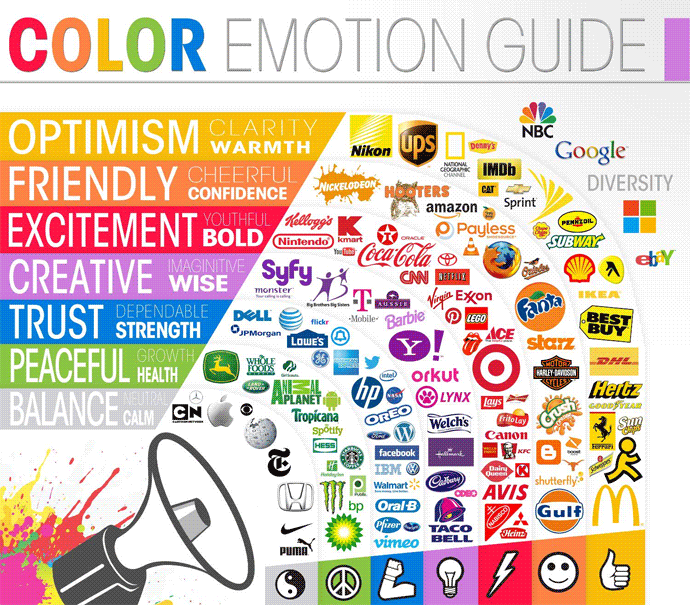
Now, you know what Coca-Cola’s iconic brand color is, but think about how many times you’ve seen a Coca-Cola product and advertisement in order to think of the company each and every time you see the iconic red color.
When working with branding, repetitiveness and consistency is the key, and social media is a great place to incorporate your brand colors to continuously remind your audience about your brand colors and make them associate them with your brand.
Once you’ve decided what brand colors you want to make part of your company’s image and social media branding strategy, it’s time to start incorporating this
When you take a look at Sprite’s Twitter account, for example, there’s no question about which color they want you to associate their brand with.
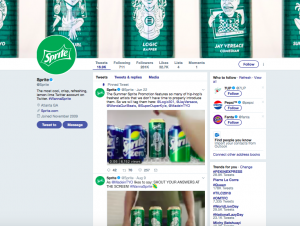
Now, your brand colors should be universal and showcased everywhere your audience comes in contact with you, whether it be your profile, your posts, or your profile picture, and one aspect of your visual theme is incorporating your brand’s colors into your posts in a seamless and effective way. As you can see from Starbuck’s post, they incorporate their iconic green color in a seamless and non-intruding way.
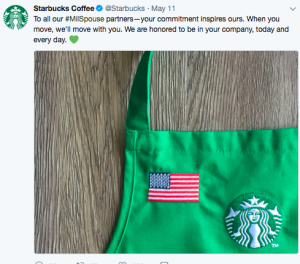
Develop your brand voice
Let’s refresh our memory of what branding is again.
Branding is ”the process of giving a meaning to a specific company, products or services by creating and shaping a brand in consumers’ minds. It is a strategy designed by companies to help people to quickly identify their products and organization, and give them a reason to choose their products over the competition’s, by clarifying what this particular brand is and is not.”
This means that branding is not only visually -driven, but every way your audience comes in contact with you, and creates an image and perception about your brand in their head.
In other words what they think about when they think about your brand, and what they associate with it.
As such, your brand’s voice plays an important role in your social media branding strategy, because in many cases, you’re probably interacting with your audience by voice than you’re doing with visual content – even if voice and visual complement and work together at most times.
This means that you also want to develop your brand voice.
The good news?
Now that you’ve defined how you want your audience to perceive your brand and how you want them to view your brand, developing your brand’s voice and tone becomes easy.
You know how you want your audience to perceive, you. Now, you just want to look a little closer at your target audience and what language and voice they use in order to make them resonate with you better.
My single best social media branding strategy example is Wendy’s. As you can see, they’ve paid great attention to developing a consistent visual theme when it comes to colors, style, and feeling.
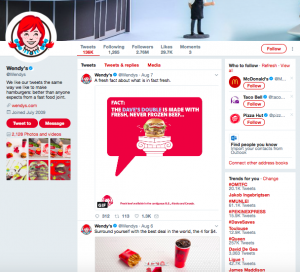
This helps the brand present themselves as fun, engaging, modern, and young. This makes sense considering their social media audience consists of younger individuals.
But they haven’t just stopped there, though. They’ve also paid great attention to developing a voice and tone which aligns with their visual branding strategy but most importantly resonates with their target audience.
The result?
A sarcastic yet fun brand voice and tone which has helped Wendy’s become a huge success on social media.
Deputy says this about Wendy’s branding strategy when it comes to developing a brand voice ”Wendy’s social media team represent the personality of the brand at every point. Wendy’s team are familiar with its voice and target audience and provide consistency across all media channels.”
The most important part? They keep a consistent tone of voice.
Consistency may be even more important when it comes to branding through voice, because your voice and tone plays such an important role in your brand personality and how your audience perceives you. Consistency also allows your audience to know what to expect and thus build better and stronger relationships with you.
Be authentic
In developing your brand voice, authenticity always wins.
After seeing the success of brands like Wendy’s by creating a witty brand voice, it may be appealing to replicate that, but remember that you cannot change your target audience’s personality unless you change target audience. While their unique voice works for them, it may not work for you. Additionally, choosing a brand voice like that may not align with your overall brand personality and social media branding strategy.
A study by SproutSocial found that the second most annoying thing people thought that brand did on social media was to use slang and jargon. And followed closely behind is ”not having any personality on their accounts”, and not too far behind is ”trying to be funny when they’re not”.
This is quite interesting since all of these three annoying things have to do with social media branding.
This goes to show just how important it is how your target audience perceives your brand.
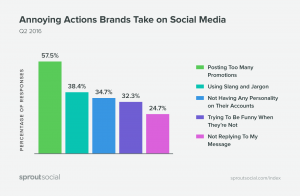
What can we learn from this?
Well, first off, it’s crucial that you understand your target audience, and understand that relatively few brands should use slang and jargon in their social media marketing, like Wendy’s, because most brands just don’t have a brand personality that aligns with this, nor do they have a target audience which will relate with it. At the same time, Attempts of using slang and jargon can in the customers’ eyes be seen as trying to be funny when they’re not, and this is yet another of the actions that people think is the most annoying on social media.
Lastly, the study proved that personality is crucial on social media, and developing your brand voice and tone that is true to your brand is an important part of that.
Furthermore, SproutSocial found that the number one behavior customers want from brands on social media is honesty – which to a large extent is integrated with authenticity. When you are honest with your brand and your personality, you are honest about your brand and your audience.
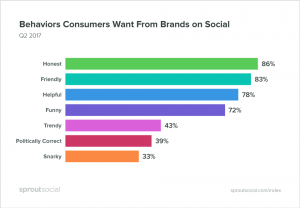
Stay consistent
I’ve already spoken about consistency quite a bit already, but now, it’s not about being consistent in your social media branding strategy. Instead, it’s about being consistent in your social media usage.
Many brands make the mistake of setting up their social media accounts, sharing a few posts… And then crickets…. For days, weeks, or even months.
When it comes to social media branding, it’s not just about being consistent in the way you portray your brand, but it’s also about being consistent in your social media usage.
After all, the reason you’re using social media is as a tool to reach your audience, and since you’re here, you want to learn how to work with branding at the same time, and apart from gaining marketing benefits form social media, also gain branding benefits.
But if you are setting up a social media account just to let it slowly fade away into the abyss of inactive accounts, how will you possibly be able to impact your audience? In fact, how will you even be able to reach your audience?
Hint: you won’t.
To succeed with social media, no matter what you’re using it for, you need to use it consistently. Social media will only yield results after continuous and consistent use,
and simply leaving your accounts to dust won’t do any of that.
Tying together with what I said at the beginning of this post (well done if you’ve both made it this far AND remembered what I said) about social media not being a promotional tool, despite so many marketers and businesses using it like any other traditional marketing tool.
Here’s the deal:
Social media is called social for a reason. The way you drive results, whether you’re looking to build your brand or simply drive more sales, the way you drive these results isn’t by sharing as many promotional messages as you can, because frankly, people don’t want to see that.
Instead, the best way is to use social media as a relationship and interaction tool, and before I jump into the next point, I want to say that engagement and interaction with your audience demand consistent and daily usage. It’s simply not enough to hop on every once in a while, because people expect responses from you and they expect them fast.
Make engagement the center of your social media branding strategy
Phew, the last point of this extensive article. My eyes are bleeding and my fingers are sore. But hey, we’ve had a good time, haven’t we?
Now, the single best way to use social media -no matter what business objective you have is to use social media as a relationship tool, not a promotional tool.
To most, this is a concept that is unheard of, but it actually makes a lot of sense.
By focusing on building your customer relationships, you’ll naturally make them more loyal and engaged in your brand. They’ll not only return to continue to engage with you on social media because they feel appreciated, valued, and seen, but they’ll also become loyal advocates of your brand who don’t say anything but positive things about your brand to their peers.
Focusing on using social media as a relationship tool may seem far away from your social media branding strategy, but the fact is that it has everything to do with your branding strategy.
First off, by making your audience more loyal, you’ll be able to reach them more often, as they’ll stick around longer, and they’ll return more frequently. Also, when you’re interacting and engaging with your audience, you create tremendous opportunities to showcase your brand’s personality.
I mean, most of the viral Tweets that wendy’s have had has been Tweets with which they’ve engaged with their audience.

Whatever you do, don’t underestimate the power of social media when it comes to customer engagement, because never in the history of this world has companies and marketers had a tool so incredible as social media which allows for direct and instant communication with their target audience – no matter where in the world they are. And, in a matter of seconds.
Wow.
An important part of this is making sure that you respond to all your messages. Have in mind that both the things you do and the things you don’t do affect how your brand is perceived and thus your social media branding.
After all, SproutSocial found that 24,7% of customers find it annoying when brands don’t respond to them on social media. Additionally, they found that people expect brands to respond within 4 hours. In other words, 100% of customers expect brands to respond on social media. After all, why would customers write to brands on social media if they didn’t expect a response?
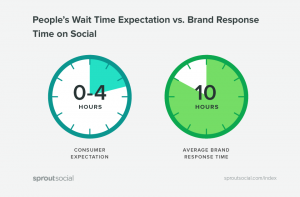
With this in mind, make sure you respond to all messages you receive from your audience because this will send signals to your audience that you value and appreciate them. This is, of course, good news for your social media branding strategy, as it will impact how your audience perceives you.
Whether you choose to execute this strategy by yourself or hire an agency, the most important part is that you follow a clear strategy.


